25th November:
Doonfoot ( Map) and Troon Harbour
With miserable weather rolling continuously from the east, it was
another case of “west is best”. I fancied a late autumn
look at Doonfoot to the south of Ayr so we hightailed it down the M77,
encouraged by blue sunny skies. We nipped into the cafe at Kilmarnock
Asda. Our previous visit there was quite disappointing but I’m
glad to report that they were back on form (9.5/10, 1/2 off for a
dripping teapot). When we emerged from the cafe we were disappointed to
find that the sky had clouded over, and, sadly, that’s how it
stayed for the rest of the day.
Doonfoot ( Website)
At the car park by the bridge across the mouth of the River Doon we
were very pleased that, despite the low light levels, we could hear and
see birds in the bushes and on the lagoon that is over the grassy bank
immediately north of the car park. A Black-headed Gull was paddling up
and down the lagoon trying to agitate the mud to dislodge
invertebrates. John pointed out a flock of roosting Redshanks to the
right on the far side of the lagoon. Standing amongst them were three Greenshanks .
As I snapped a quick record shot before edging a bit closer, a Robin
started singing from a bush a few feet from my ear. We scrambled down
from the grassy bank and sneaked along a rough path to manage quite
close pictures of the Greenshanks, as well as a few of Teal dabbling
happily by the water’s edge.
| Black - headed Gull |
Greenshank |
Robin |
Teal |
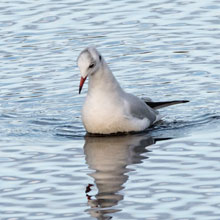 |
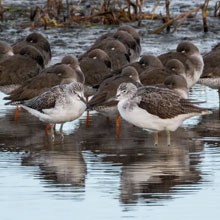 |
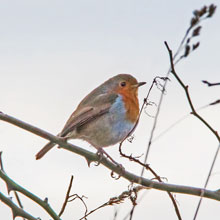 |
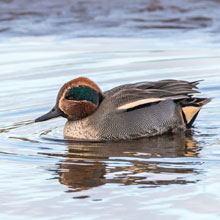 |
A few Redshank were active on the sands at the mouth of the Doon beside
about a dozen Carrion Crows noisily competing for any available food.
As I captured a few images of these, about 10 Mallards puddled up to
us. They obviously mistook us for feeders (rather than merely
observers). I also took pictures of Yarrow , the only flowering plant I could see in the area.
| Redshank |
Carrion Crow |
Mallard |
Yarrow |
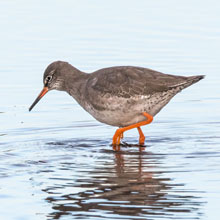 |
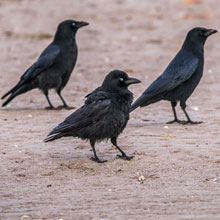 |
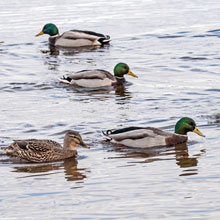 |
 |
John directed my attention to a wee Pied Wagtail chirping its way along
the shallow stream that connects the lagoon to the river. He also
noticed a Little Grebe
with a bit of foliage in its beak paddling along the opposite side of
the river. It soon dived and re-emerging a fair distance downstream.
The light had deteriorated badly by this time and we decided to return
to the car. On the way we passed a couple of nice birds, a Yellowhammer
nestling in a bare Hawthorn bush and a Goldfinch picking seeds off of
Knapweed seed heads (see also “Pictures of the Week”,
below).
| Wagtail |
Little Grebe |
Yellowhammer |
Goldfinch |
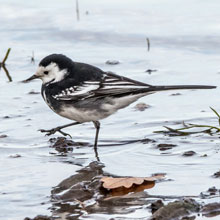 |
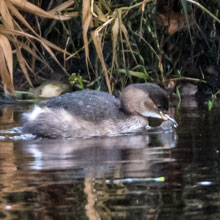 |
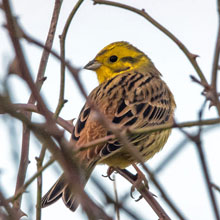 |
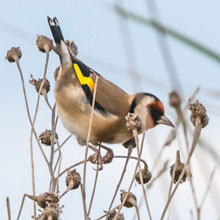 |
We drove the short distance south to the Greenan Shore carpark. A few
House Sparrows (see also “Pictures of the Week”, below)
were on the bushes there as we set off along the shore towards the
Castle, but the tide was in and the path was relatively busy with dog
walkers, so it wasn’t too long before I decided we should cut our
losses and head elsewhere. Just before we reached the car we came
across a female Blackbird on a bush. It was so dull to the naked eye we
could hardly make it out from about 8m away. I was able to get the
right exposure settings though, so the photo shows more than we saw. We
decided to go to Troon to have a go at finding the reported Water Pipit.
As we left the car park I stopped and snapped a few shots of a Magpie
on a bush by the roadside. By luck, a couple of Greenfinches joined it
on the bush. The winter plumage
of males and females is almost identical but I’m identifying the
one below as female as its plumage looks fairly dull.
| House Sparrow |
Female Blackbird |
Magpie |
Greenfinch |
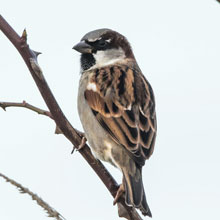 |
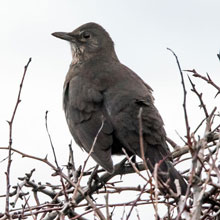 |
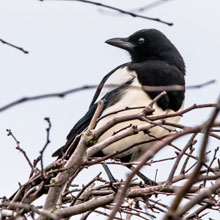 |
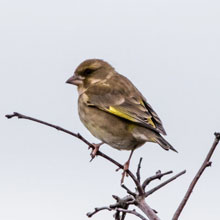 |
Troon
On arrival at the Harbour car park at the north end of the Ballast
Bank, we could see the heads of at least 4 Grey Seals bobbing up and
down 50m offshore. Our plan to seek out the Water Pipit was to follow
the path below the Ballast Bank, towards the South Beach, as that was
the stretch mentioned in reports. Our first sightings were of the
ubiquitous Oystercatchers roosting, each with beak tucked under wing
and one beady eye watching for danger. Close by, we were pleased to
discover two other species of roosting birds. The first of these was the
Purple Sandpiper , which inexperienced observers often mistake for the Redshank .
To tell them apart, what I always look for is the leg colour: Redshanks
have very orange legs, while Purple Sandpipers legs are a dull yellow.
The other roosting species was the Golden Plover. Even in the very poor light their golden plumage was easily noticed.
| Grey Seal |
Oystercatcher |
Purple Sandpiper |
Golden Plover |
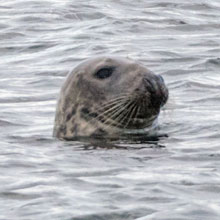 |
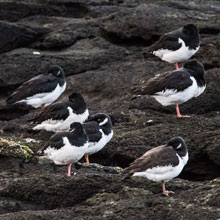 |
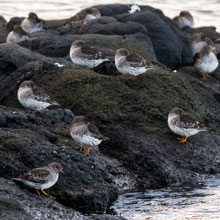 |
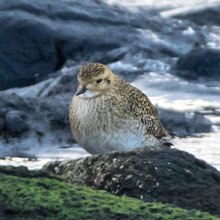 |
As we stood on the edge of the shore observing the birds on the rocky
shore, our excitement levels were raised as we heard the cheeps of a
Pipit coming from the boulders just ahead of us. When I eventually
located it I was disappointed that it wasn’t a Water Pipit, but a
Meadow Pipit .
We were looking for a wee bird with almost plain white underparts, but
this one had a streaked white underbelly. Then, suddenly, all the
roosting birds we’d been watching went up, flying off to the south.
Soon after we could see what had put them up. A lone canoeist paddle
past, just beyond the rocks. At this we set off along the side of the
Ballast Bank. All we saw along that stretch were a pair of squabbling
Starlings.
| Meadow Pipit |
Purple Sandpiper |
|
Starling |
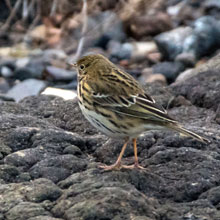 |
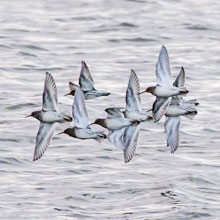 |
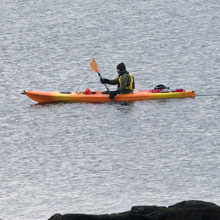 |
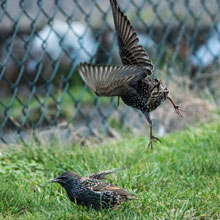 |
Beyond the Ballast Bank we paused to take in the lovely view to the
south. The light was dimming by the minute, although it was obviously
brighter beyond Ailsa Craig.
A Shag flew past us travelling in the opposite direction, then a flock of
Dunlin flew in to the rocks just before us. I then noticed that there
were Golden Plover there too, perhaps they were some of the birds we
saw earlier.
As I edged a bit closer, I saw that there were also Ringed Plovers
on the rocks, juveniles as well as adults. The juveniles have lighter
plumage, duller legs and a weaker, or no, band across the chest. We had
a good look for the Water Pipit in failing light, but to no avail. We
headed back to the car. I photographed a Feral pigeon cavorting on the
shore, and a Pied Wagtail as it darted across the damp sands. At the
car park I got fairly close to a Herring Gull and also a Redshank (see
“Pictures of the Week”, below). Those were of final
sightings of the visit.
| Ringed Plover |
Juvenile Ringed Plover |
Feral Pigeon |
Pied Wagtail |
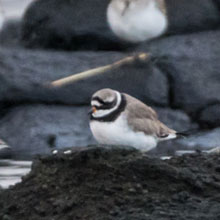 |
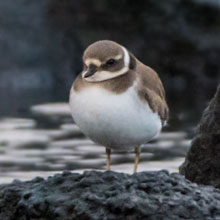 |
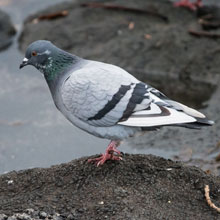 |
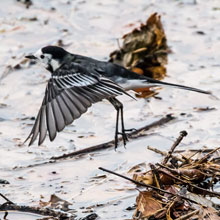 |
Midway through the trip I had said to John that I felt as if we were
trying to take photographs in the dark. That is how it felt. Still, we
managed a fair haul of observations and, thanks to a decent camera and
a little help from Photoshop, the pictures are passable. Of course, the
indispensable part of every trip is our tea break, and this one was no
different. The Danish pastries were delicious. As for the Water Pipit, I
may catch up with it in the near future.
Pictures of the Week:
| Goldfinch |
House Sparrow |
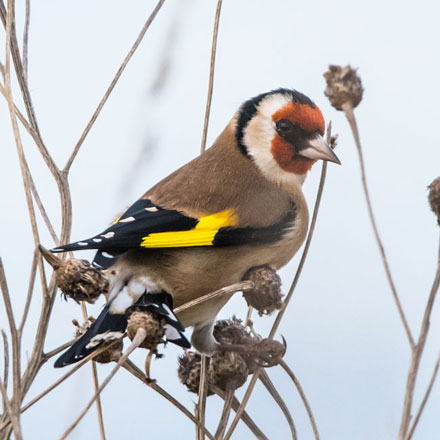 |
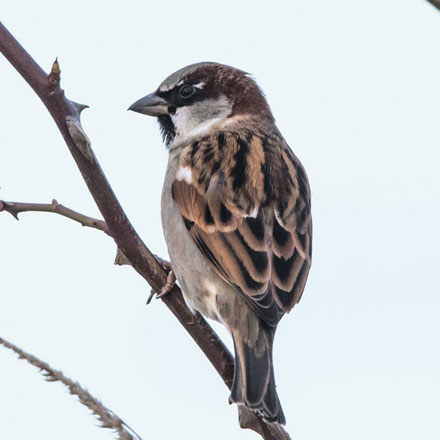 |
| Herring Gull |
Redshank |
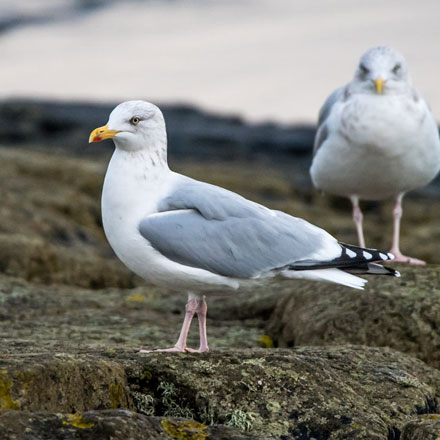 |
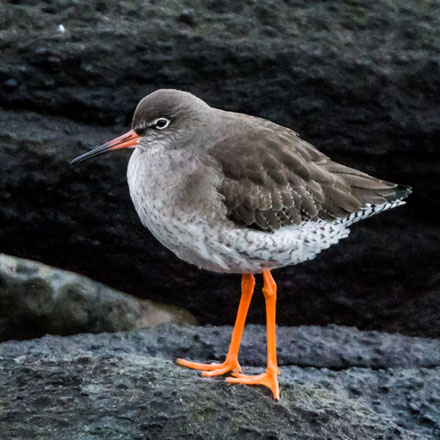 |
18th November 2018 : Skateraw
and Belhaven Bay
We were delighted to hear from the Saturday evening weather report that
Sunday was to be bright and mild right across the whole of the country.
We hadn’t been East for 5 weeks, so I decided to head to the
Dunbar area, although we were worried that the east coast may have been
shrouded in mist. Of course, on the way we called in at Dalkeith
Morrisons for some breakfast which we both enjoyed despite the kitchen
getting my order slightly wrong (9/10).
Skateraw:
As the car rolled down the brae that leads to Skateraw Harbour, we were
relieved to see the coast was clear of haar ,
although we could see a huge band of cloud low to the north and east
(this would move in after we left). As we got out of the car John
noticed that there was a freshly built memorial plaque just beyond the
toilet block. It marks the site of a First World War airfield
where British war planes could make emergency landings. Our
first
bird sighting was, predictably, a handsome wee Redshank patrolling the
rocky shore of Skateraw Harbour. Rock Pipits were also busy seeking out
invertebrates hidden within masses of seaweed rotting on on the shingle
shore. To the west we could see the Barns Ness lighthouse. Through the
binoculars we could just make out crowds of cross-country runners
tearing along the beach - hardly what you’d expect in a
treasured
natural environment.
| Memorial |
Redshank |
Rock Pipit |
Barns Ness Lighthouse |
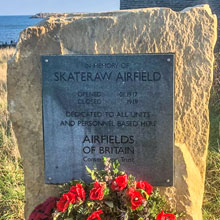 |
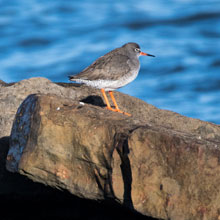 |
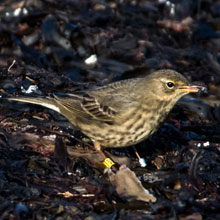 |
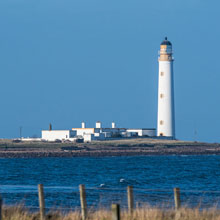 |
We walked the short journey out to Chapel Point, passing briefly through
a low patch of Wild Roses, now dying back as Autumn nears its end. We
paused at another memorial,
this time dedicated to the memory of six young men of the Canongate
Boys’ Club who died in World War Two, and to their much
respected
leader, the Very Rev. RWVS Wright. Beyond the cross, on the rocks
stretching out from the Point, a large variety of birds were gathered.
We sat quietly and watched Mallards, and Turnstones fly past.
| Wild Rose |
Canongate Memorial |
Mallard |
Turnstone |
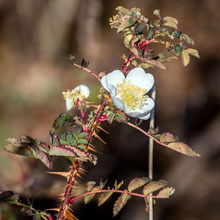 |
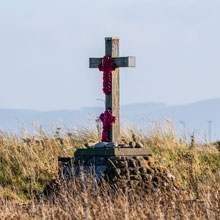 |
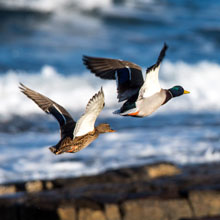 |
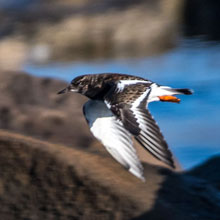 |
John was briefly confused by an unusual-shaped rock that managed to
convince his brain that it was a Seal. I could see how it deceived him
as it had a very rounded tip, which, on closer inspection was crusted
in shellfish. Amongst the flocks of birds on the rocks I spotted Curlew,
a few Ringed Plovers and lots of Oystercatchers.
|
Curlew |
Ringed Plover |
Oystercatcher |
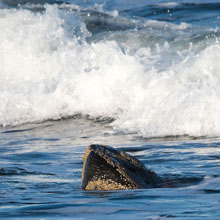 |
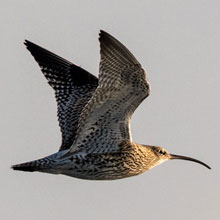 |
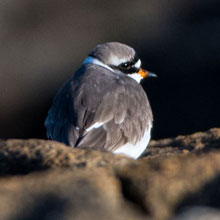 |
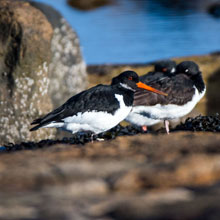 |
A hundred metres offshore we could see quite an unusual sight, a pair of
guys in Kayaks, each with a pair of fishing rods. It was time to head
back to the car. At the harbour slipway I snapped a nice little Pied
Wagtail and also a male Linnet. As we drove out of the village I
captured an image of a Carrion Crow at the west edge of the field that
was used formerly as the WWI aircraft runway.
|
Pied Wagtail |
Linnet |
Carrion Crow |
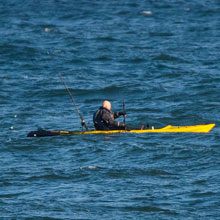 |
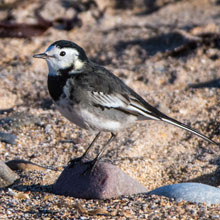 |
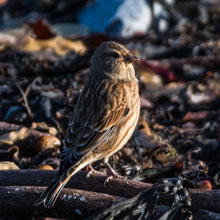 |
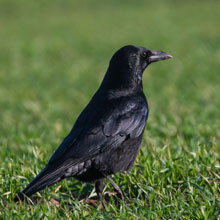 |
Belhaven Bay:
We parked in the Shore Road car park at Belhaven and climbed the large
style over the dyke onto the footpath along the south end of Belhaven
Bay. We were delighted that the sun was still shining brightly. It had
a slightly golden hue, as shown by the view of the Bay, below. The tide
had long since ebbed away leaving only a few birds on the sands. Among
these was a Hooded
Crow
that was foraging for whatever it could get. It was spooked by large
party of dog walkers, which gave me a nice photo-opportunity. Another
bird offered a chance of interesting shots. I noticed a Redshank was
trying to consume a little silver fish it had caught (also see
“Pictures of the Week”, below). I wasn’t
aware that Redshanks
ate fish - but apparently they do. Next we moved across to an area
adjacent to the Belhaven Bay Caravan Park, where the Seafield Pond lies.
Although it looks like an ornamental feature, it used to be a clay pit
for local brickworks. A large juvenile Grey Heron was sitting on the
near bank of the pond until a dog walker put it up (see
“Pictures
of the Week”, below).
| Belhaven Bay |
Hooded Crow |
Redshank |
Grey Heron |
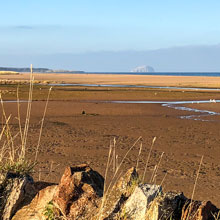 |
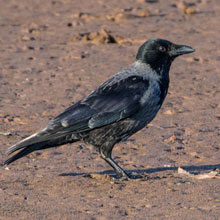 |
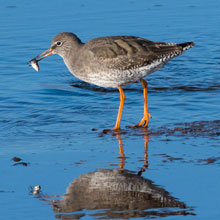 |
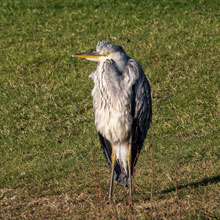 |
On the grass just beyond the Heron a large flock of over 100 Wigeon were
feeding. John excitedly drew my attention to a drake Mandarin duck
he’d spotted on the water amongst Mallards and Tufties. It
was
some distance away from us, in the shade and against the light. We
tried to sneak across the open area of short grass between the caravans
and pond, but we couldn’t avoid spooking the Wigeon into the
south end of the pond (see “Pictures of the Week”,
below),
and encouraging the Mandarin into the narrow section behind tall reeds.
Sadly, it never re-emerged. Unlike the other birds, a family of Mute
Swans crowded around us looking for food. They too were scared off by,
yes you’ve guessed it, a dog whose careless owner had let it
off
the lead. The picture below shows the poor hissing Swan running back
into the water. The Mallards watched on with interest.
| Wigeon |
Mandarin Duck |
Mute Swan |
Drake Mallard |
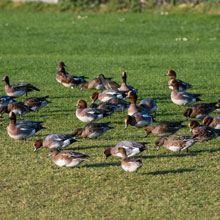 |
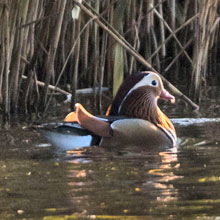 |
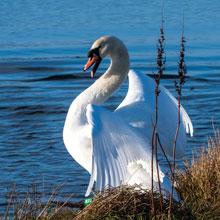 |
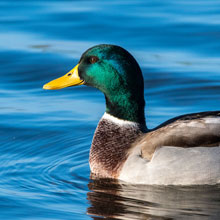 |
In a quiet wooded section by a caravan I noticed a lot of small birds
moving on and off a couple of feeders. I managed a few shots of these passerines ,
including Blue Tits, Coal Tits, Chaffinches and a
Tree Sparrow
| Blue Tit |
Chaffinch |
Coal Tit |
Tree Sparrow |
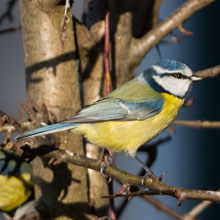 |
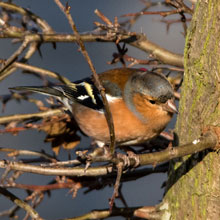 |
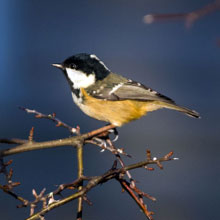 |
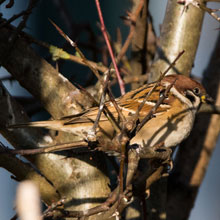 |
Back at the pond, a solitary female Goosander flew in from beyond the
sea wall and, soon after, a large Herring Gull flew low overhead. An
attractive Coot paddled very close, nodding as it went (see
“Pictures of the Week”, below). Having bagged over
40
potential subjects for this blog (not all made the “final
cut” though), we decided to call it a day and made our way
back
around the pond. Unfortunately we had to unsettle a few more Wigeon on
the way, gaining a few more nice shots though. Our final shot was of one
of my favourite birds, that is so ugly it is beautiful, a Rook .
| Female Goosander |
Herring Gull |
Wigeon |
Rook |
 |
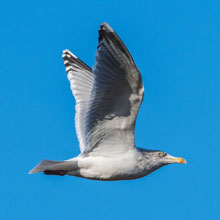 |
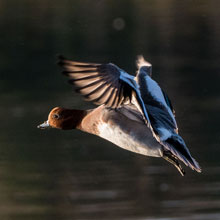 |
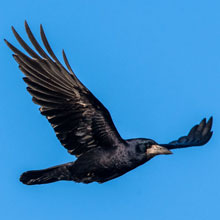 |
What a fine day we had had with lots of interesting sights and pictures,
especially at Belhaven. The weather had held up until just after we
drove back west at late afternoon, when the cloud, that had been
lurking low in the east, finally rolled in. But just before we left we
enjoyed our customary Danish pastry and strong tea, rounding off a very
successful outing.
Pictures of the Week:
| Redshank |
Wigeon |
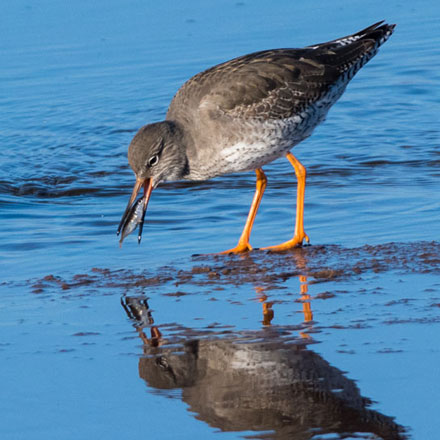 |
 |
| Grey Heron |
Coot |
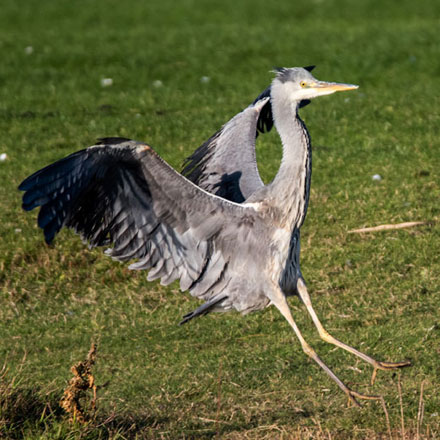 |
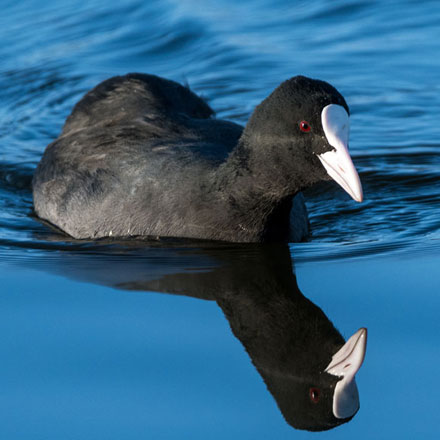 |
11th November 2018 :
Troon
and Irvine
Harbour
The weather predictions for Central Scotland were not encouraging. A
period of rain was to have cleared slowly from the west. I decided to
go to the Ballast Bank at Troon and hoped conditions would improve as
the afternoon progressed. We visited Stewartfield Morrisons cafe for
breakfast (8/10, slow service) before travelling through some quite
nasty weather, via the M77, to
Troon.
Troon
The rain had eased as we arrived in Troon. We noticed bird flocks busy
on the shore near the North Shore Road car park. The light was very
poor for photography, nevertheless, I was able to take some record
shots of some small waders that were shuffling across the damp sand.
Redshanks and Dunlin made up much of the flock but I also spotted a few
Ringed Plover and the odd Oystercatcher. I also captured an image of
rain-soaked Bittersweet berries (see “Pictures of the
Week”, below).
| Redshank |
Dunlin |
Ringed Plover |
Oystercatcher |
 |
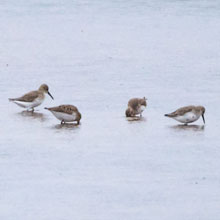 |
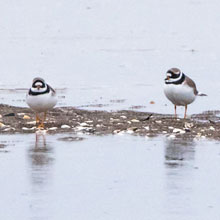 |
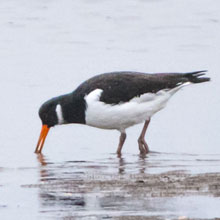 |
We didn’t spend long at the North Shore Road as the rain was
intensifying. Instead we drove along Harbour Road to the car park at
the north end of Ballast
Bank. We sat there in the car until the rain went off. The
tide was coming in as we moved slowly along the north shore. A few Turnstones
were picking their way along the shingle beach, foraging for
invertebrates. We then came across a juvenile Great Black-backed Gull
(2nd calendar year) fending off other smaller gulls that were after the
large fish it had claimed. Anxious to consume it as quickly as possible
before it could lose it to a more dominant gull, it tried to down it in
one but try as it might, the fish was just too big. The Turnstones we
had been watching earlier suddenly fled off around the harbour wall.
| Turnstone |
2nd Cycle Greater Black - |
backed Gull
with lunch |
Turnstone |
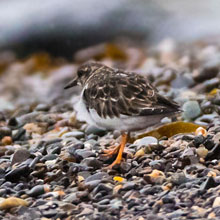 |
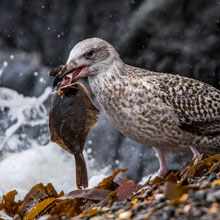 |
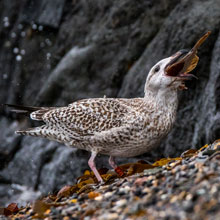 |
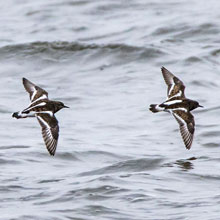 |
A pair of very pretty drake Eider passed overhead heading south. John
spotted the bobbing snout of a Grey
Seal only
about 20m out. We then decided to walk along the shore along the length
of the Ballast Bank. A pair of Oystercatchers and a Redshank were
standing in the rain. I wondered if they were as annoyed as us that it
hadn’t cleared up by then.
| Common Eider |
Grey Seal |
Oystercatcher |
Redshank |
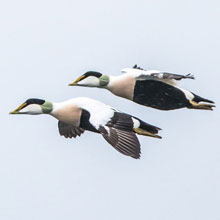 |
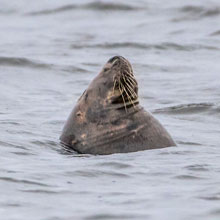 |
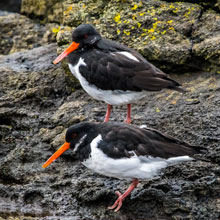 |
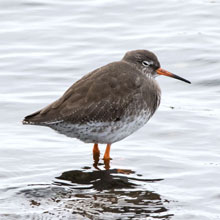 |
A Shag flew south. We discussed the quickest way of telling Shags
from Cormorants.
I always look at forehead, eyes and beak. In the Shag, the beak and
forehead meet at a point rather than being on a continuous line. The
Shag’s eye set in feathered plumage rather than edging onto
an
unfeathered area. Lastly, the Shag’s beak is slimmer and
doesn’t have as prominent a hooked tip as that of a
Cormorant. A
wee Rock Pipit made a brief appearance. We had had an eye open for a
reported Water
Pipit
but it didn’t show, sadly. However, a small flock of Purple
Sandpipers did make an appearance. They weren’t very skittish
so
I was able to get some close shots, albeit in poor light. Near the car
I got a picture of a Starling, but the light was so low, and the rain
was so unrelenting that we decided to move north to Irvine Harbour. We
could see that it was much brighter there.
| Shag |
Rock Pipit |
Purple Sandpiper |
Starling |
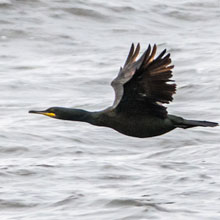 |
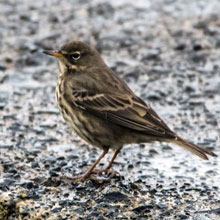 |
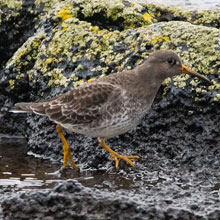 |
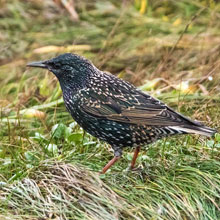 |
Irvine
Harbour :
We got a very sunny welcome at the Irvine Harbour car park as is shown
by the panorama below. The sunlight broke through the rain clouds and
created a double
rainbow
as it fell on the last of the raindrops
.
Heartened by the presence of light, we set off along the path toward the
mouth of the River Irvine. As we passed the “Bridge of
Scottish
Inventions” we saw a Shag sitting drying its wings, midstream
on
top of a metal post. Close to there, a Grey Seal, very like the one we
saw at Troon, appeared for a short time before submerging and
disappearing out of sight. A majestic adult Great
Black-backed Gull
coasted past overhead to survey the sand dunes to the south of the
river. Higher in the sky, and travelling in the opposite direction, a
Coastguard rescue helicopter passed by, probably travelling from
Prestwick to Glasgow airports.
| Shag |
Grey Seal |
Great Black - backed Gull |
Coastguard |
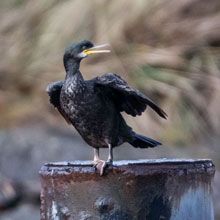 |
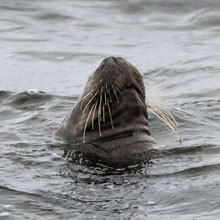 |
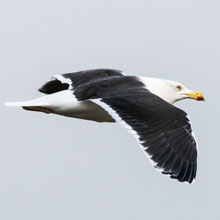 |
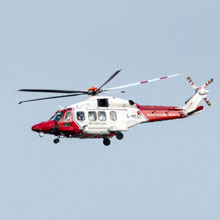 |
Next we got our first view of a Cormorant, a handsome specimen dashing
down the Irvine, bathed in orange sunlight. Note the heavy hooked beak
and shallow-sloping forehead. John was amused by a pavement Lottery
sign that was pathetically bobbing at the edge of the water. Perhaps a
customer was so disillusioned he chucked into the river, or maybe it
was a mindless vandal. Next to the Coastwatch/toilet block, a
fine-looking Herring Gull sat waiting for that tasty chip casually
tossed from one of the many parked cars. At the viewpoint at the end of
the walkway we got a dramatic and very picturesque, and amber, view of
Ailsa Craig some 50 miles to the south.
As we walked back to the car, a Red-breasted Merganser flew up stream,
emptying its store of guano as it passed. Yet another Shag eyed us as I
snapped it, while a few metres away, a Common Seal surfaced for a few
moments until it noticed it was getting its picture taken. Note the
“W” shaped nostrils and
“dog-like” head, which
are characteristics of the Common Seal. Our final shots were of a pair
of birds that were hanging around the car as we prepared for tea, a
Carrion Crow and a Jackdaw (see “Pictures of the
Week”,
below). They were lucky as I had kept a few bits of food from the
morning’s breakfast. There was no way they were getting any
of
our pastries, but they were very enthusiastic when I chucked them bits
of toast and fried bread - in competition with sharp-eyed gulls who
wasted no time zooming in on the goodies.
| Red - breasted Merganser |
Cormorant |
Common Seal |
Carrion Crow |
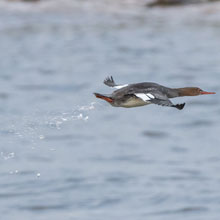 |
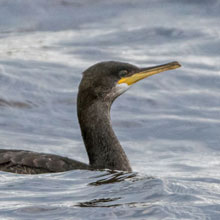 |
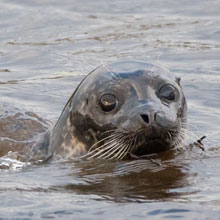 |
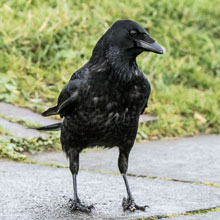 |
We had endured another spell of miserable weather, but another fairly
satisfactory day in terms of sightings. We had cream filled chocolate
eclairs with our teas. We do hope for better weather next week.
Pictures of the Week:
| Bittersweet |
Purple Sandpiper |
 |
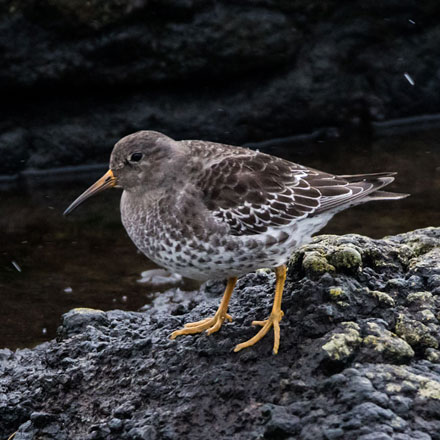 |
| Irvine Harbour |
Jackdaw |
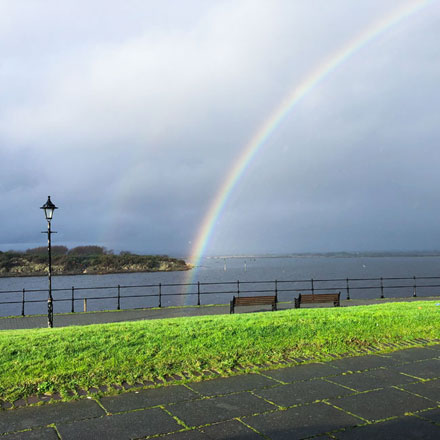 |
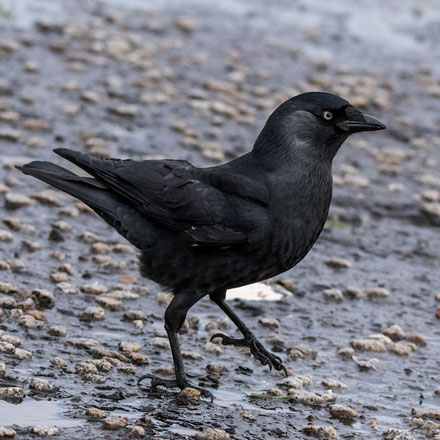 |
4th November 2018:
Stevenston and Saltcoats
Brighter weather was forecast for the west coast of Central Scotland so
we made for “old faithful”, Stevenston. Our usual
breakfast
choices at the normally brilliant Stevenston Morrisons Cafe were
disrupted by some annoying menu changes (7/10). On Stevenston Point we
were surprised by the strength of the wind and roughness of the sea.
The tide was high but ebbing and birds seemed unsettled by the
conditions. As we got out of the car, a sizeable flock of small
waders
flew north over the Point. These were mainly Ringed Plovers, Sanderlings
and Dunlin. On the water south of the Point, many Black-headed Gulls
were bobbing up and down and only very occasionally would they take to
the wing (see “Pictures of the Week”, below).
| Stevenston Headland |
Ringed Plover |
Sanderling |
Black - headed Gull |
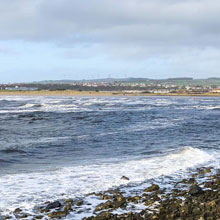 |
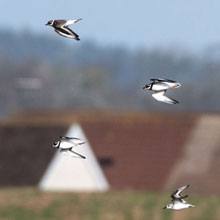 |
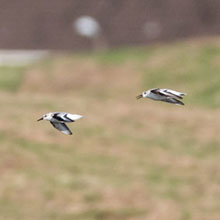 |
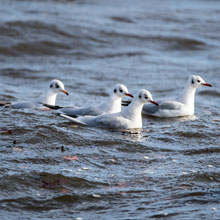 |
A 3rd cycle Herring Gull seemed perfectly at ease as it hovered in the
wind. John pointed out that the waves had created sea foam,
or spume, on the rocky shore. Next our attention was drawn to
the
concrete outflow that had emerged into view as the tide fell. A Redshank
and 5 Purple
Sandpipers were wading in the shallow water over
the concrete structure.
| 3rd Cycle Herring Gull |
Spume |
Redshank |
Purple Sandpiper |
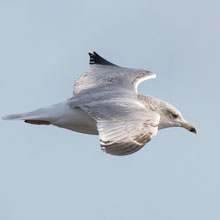 |
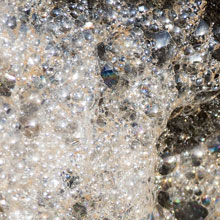 |
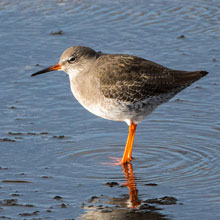 |
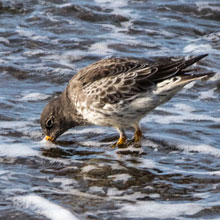 |
A 1st cycle Herring Gull coasted over the choppy waters followed by a
few Black-headed Gulls. A lone juvenile Oystercatcher with a dirty bill
completed our observations on the Point as we’d decided to
check
out the Ardeer
Quarry LNR ,
as we had not been there for a while. On arrival I got a couple of nice
shots of a Mallard nicely lit by the low Autumn sun (see
“Pictures of the Week”, below).
| 1st Cycle Herring Gull |
Black - headed Gull |
Oystercatcher |
Mallard |
 |
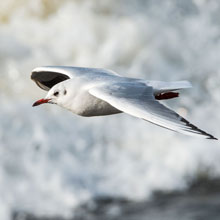 |
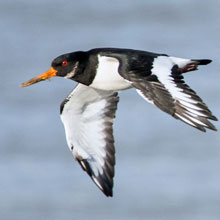 |
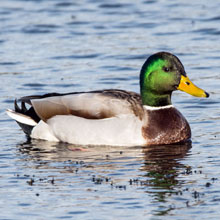 |
A family of Mute Swans looked right at home at the north end of the
pond, but that was about it. The rest of the pond was very quiet, but
then I spotted a flock of Curlew in what used to be a pitch and putt
course. As we moved to a better position to photograph the Curlews I
snapped a wee chattering Wren (see “Pictures of the
Week”,
below) and, in the same bush, a Robin and a Dunnock. Before we could
get to the Curlews, a dog walker put them up. All was not lost though
as they settled some 100m away, at a point we’d pass on our
way
around the reserve.
| Mute Swan |
Wren |
Robin |
Dunnock |
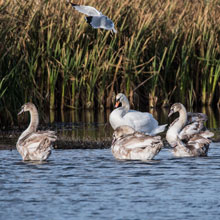 |
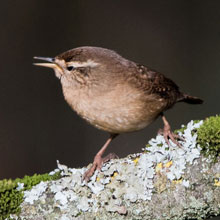 |
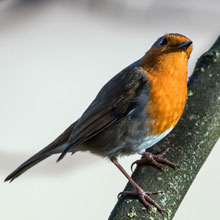 |
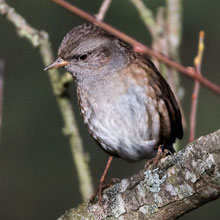 |
A few years ago the managers of the nearby Ardeer
Peninsula
ordered a cull of “a three figure number” of Roe
Deer. Since
then, fewer Roe Deer have been seen in the Ardeer Quarry LNR. We
didn’t see any on this visit. Many of the footpaths were
lined
with berry-laden Hawthorn bushes. We were disappointed not to find any Blackbirds,
Thrushes or Starlings feeding on those red berries. As our mild Autumn
continued I noticed a few flies were still about, some resting on oak
leaves, lapping up the sunshine. The Curlews has moved on again from
where we had seen them settle, however I did see some Great Tits were
flitting about feeding in the high branches, but there were far fewer
birds than we had expected. On our way back to the car though we passed
the Curlew flock in the place we had first noticed it. They were fairly
close and very well lit.
| Common Hawthorn Berries |
Fly - Graphomya maculata |
Great Tit |
Curlew |
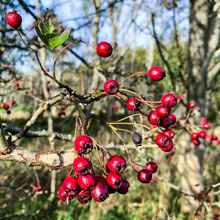 |
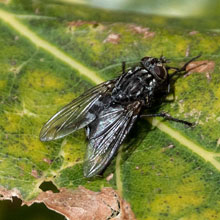 |
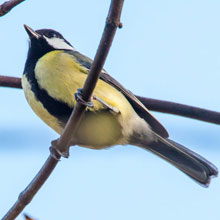 |
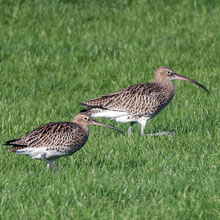 |
Our final destination was Saltcoats Harbour. There was still a stiff
breeze but the tide had receded a fair bit. Oystercatchers and Curlews
were picking their way across the damp rocky shore. As we moved around
the sea wall we passed an adult Herring Gull that was sitting rather
regally on top of tall rock. John spotted a Seal bobbing up and down in
the choppy waters some 50m offshore. I, sadly, didn’t catch it
before it dived, never to be seen again.
| Saltcoats Harbour |
Oystercatcher |
Curlew |
Herring Gull |
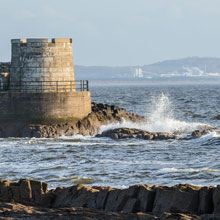 |
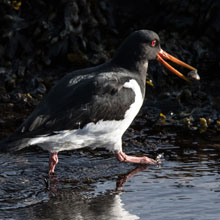 |
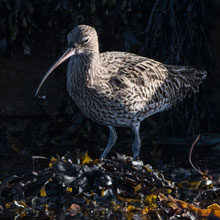 |
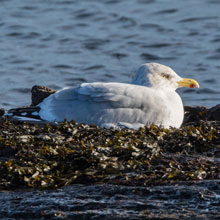 |
The view to the north across South Bay to Ardrossan is dominated by the
Ardrossan
Wind Farm high
above the town. As I photographed the windmills from the
promenade, a pair of Herring Gull were sounding off below me.
What
they were getting quite so animated about, I’m not sure, but
it
probably involved food. I snapped a few Turnstones
foraging amongst the seaweed. Back at the car, just as we settled for
tea, our final picture of the day was of a young Starling that was
moving in amber light about the car park picking up little morsels left
by those messy humans.
| Ardrossan Wind Farm |
Herring Gull |
Turnstone |
Starling |
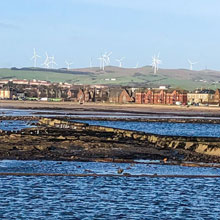 |
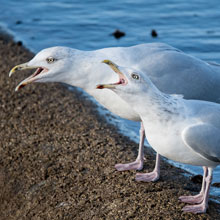 |
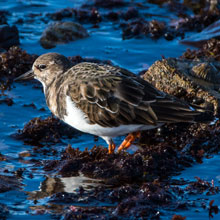 |
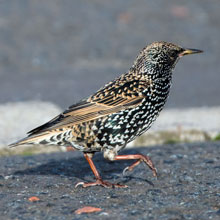 |
The tea was accompanied by a delicious vanilla and almond Danish
pastry. We were fairly satisfied with our haul. Ardeer Quarry LNR was a
bit of a let-down though. In the past we’ve seen a lot more
there, such as Roe Deer, Buzzard and Kestrel. The local newspaper
reported recently of regular anti-social
behaviour in the Reserve . What a shame it might be
having a bad effect on the consolidation of the site as a nature reserve.
Pictures of the Week:
Back To Top
|
|

